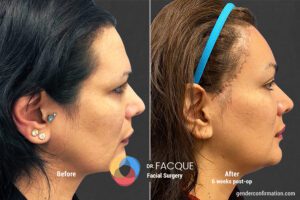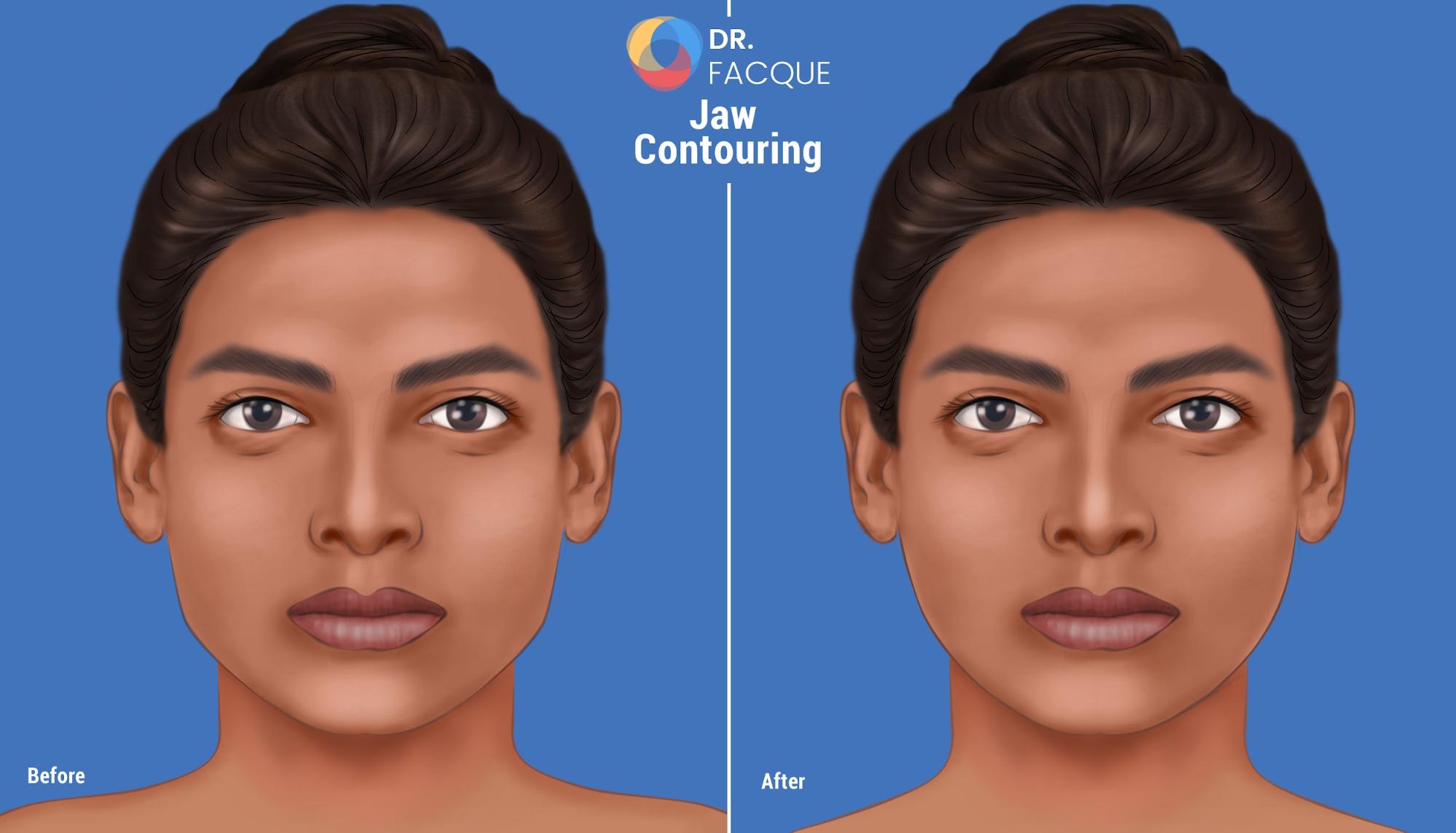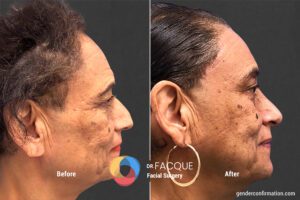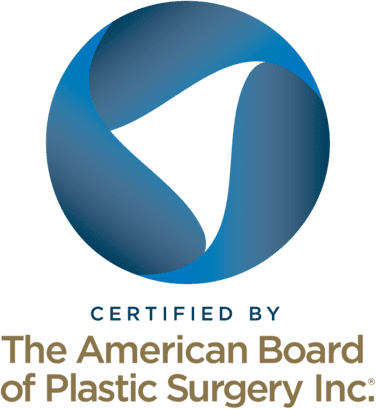Jawline Contouring: Your Surgical Options Explained
Medically reviewed by Jennifer Richman on February 07, 2024.
Jawline Contouring: What It Is and Why It Matters
There are both surgical and non-surgical approaches to jawline contouring: procedures that reshape the jaw to enhance its appearance by addressing asymmetry, sagging skin, volume loss, profile balancing and/or feminization for gender-affirmation. Surgical forms of jawline contouring in cosmetic and gender-affirming procedures have grown tremendously in popularity over the past few years. This is because unlike non-surgical options like injections or at-home techniques, surgery has long-lasting results on the profile of a patient.
Surgical Approaches to Jawline Contouring
There are a variety of surgical procedures that can contour the jawline through targeting bone, subcutaneous fat and/or skin. They include:
- Mandible contouring, which involves shaving down the jaw bone to create a permanent reduction and/or re-shaping of the jaw
- This is sometimes performed simultaneously with a genioplasty or chin reduction
-
- Jaw implants can help augment the jaw, giving it a more angular, pronounced look
- A buccal fat removal or liposuction procedure of the neck can give the jaw a more defined, pronounced appearance
- A face lift or neck lift to tighten the skin around the neck and jaw, giving a slimmer, more conventionally youthful appearance
While surgical approaches like mandible contouring and jaw augmentation yield permanent results, they are more invasive procedures and involve far more intense recovery processes. For this reason, as well as the unique goals of patients, some opt for skin tightening and/or liposuction procedures as an alternative. However, weight fluctuations and the effects of aging long-term mean that the results of these procedures may be long-lasting, but are not guaranteed to be permanent.
Surgical Candidacy for Jawline Contouring
Dr. Ellie Zara Ley (she/her/they) and Dr. Alexander Facque (he/him) both use the informed consent method to determine patient eligibility. In other words, adult patients that are educated on the advantages and disadvantages or risks of each procedure have the ability to consent to them. At this time, the GCC (Gender Confirmation Center) does not have any BMI requirements for facial surgery. However, patients should be in overall good health, stop smoking at least four weeks before and after surgery, and not consume alcohol a week before and after surgery.
Please discuss your medical history with your surgeon during your facial feminization surgery (FFS) consultation as any of the following conditions may affect your eligibility for different procedures:
- Heavy smoker, drinker, or drug user
- Uncontrolled diabetes
- Uncontrolled high blood pressure
- Bleeding or clotting disorders
- Significant lung or heart disease
- Active sinus infections
- Previous facial trauma, sinus surgeries, etc.
How is Jawline Contouring Surgery Performed?
Mandible contouring is an invasive surgical procedure that is performed under general anesthesia. This means that the patient will be completely unconscious and not have any feeling during or recollection afterwards of the procedure.
To begin, your board-certified surgeon will make incisions inside of the mouth, at the base of the lower gums, to be able to access the jaw bone. From there, the jaw will be shaved down to match the preference of the patient: whether they request a more V-shape, rounder, more angular or another jawline shape. Your surgeon can also reshape your chin, called a genioplasty, through an incision in the gumline. Incisions are then closed, most often with dissolvable sutures. Patients will wake up from surgery with a compression wrap around their face and jaw to help manage swelling.
Surgical Recovery
Following surgery, we ask patients to eat a soft diet for 2 weeks to allow the incisions in the mouth to heal. Introducing hard to scratchy foods before this time can lead to incisions opening, which can expose patients to infections. Patients should maintain good oral hygiene and brush teeth with a soft-bristle brush after meals. You may be given antiseptic mouthwash and/or oral antibiotics by your surgeon during the first week after surgery. Wearing compression wraps and icing your jawline as instructed will be essential to manage pain, discomfort and inflammation.
The incisions inside the mouth will heal over the course of those first 2 weeks. The swelling on the outside of the mouth and jaw sticks around for significantly longer. Patients can expect to be very swollen the first months following surgery, and for some swelling to remain for up to 6-9 months after surgery. Following this period, the effects of surgery start to be visible. As a result, we generally do not consider revisions on a procedure like this until at least a full year has passed.
Jawline Contouring for Gender-Affirmation: FFS
When jawline contouring is included as part of FFS, it is meant to help transgender and non-binary patients feel more congruence between their gender and the appearance of their face. During a first, testosterone-dominant puberty, the jaw bone or mandible often widens and acquires a more squarely, prominent shape. For some patients, having a large, prominent jawline provokes feelings of gender dysphoria. Thus, this procedure is meant to reverse the effects of testosterone on the growth of the jawline. Mandible contouring, alongside other FFS procedures like hairline reshaping, can help create more of a round, slim or heart-shaped face.
Non-Surgical Alternatives
While they are non-surgical and non-invasive, some cosmetic interventions and at-home techniques can be useful for those seeking an inexpensive yet visually apparent way to affect the appearance of their jaw.
Makeup Techniques for Jawline Contouring
In makeup, contouring is the practice of working with light and shadow to accentuate or create the shape of certain features. Anywhere you apply a bright or darker shade you can enhance or redefine your facial map, or framework. Certain products, like bronzer, highlight, contour sticks, contour brushes, powders and liquids can be used in the contouring step of a makeup routine.
Certain face shapes may benefit from different contouring styles. Oblong, rectangle, round, diamond, heart, and oval face shapes benefit from different contouring styles so that the facial shape is complemented. For example, an oblong shape might require a softer sculpting so that the face does not appear hollow.
It is also important to consider the qualities of the products you use to prevent any inflammation or adverse reactions to the skin on the face.
Cosmetic Procedures for a Defined Jawline
Cosmetic procedures can also help the definition and shape of the jawline. Popular cosmetic options are generally not as invasive as any surgical procedure. Options such as dermal fillers and botox are two popular cosmetic procedures that individuals partake in largely because they can be minimally altered while still offering significant effects or changes in the jawline.
Botox and dermal fillers, like any procedure done in the facial area can come with some complications. Paying attention to swelling, allergic reactions, and headaches or more serious complications. Botox and dermal fillers are temporary and will require routine follow-ups that can increase the cost. Some individuals find this flexibility beneficial because it allows them to commit to a less invasive and permanent change to the face. However, a disadvantage is that this can be costly over time.
Natural Methods to Enhance Your Jawline
While natural methods will not enhance the jawline to the degree of a cosmetic procedure or surgery, for some, they can assist in creating the appearance you would like. Some people find jawline exercises (face yoga, gua sha or rubber jaw exercising mouthpieces) to be useful natural methods. Still, there is little evidence that supports their effectiveness. Anecdotally, some believe that they have a noticeable effect on slimming their jawline.
FAQ for Jaw Contouring Surgery
Will My Insurance Cover This Surgery?
Transgender and non-binary patients who provide a therapist support letter can often get insurance coverage for FFS. Please note that most insurance providers who cover gender-affirming surgery usually require at least 12 months of uninterrupted hormone therapy before undergoing FFS.
At the GCC, our insurance concierge has a 90% success rate in securing coverage for interested patients. You can request a consultation today to get started with us.
Does Jaw Contouring Surgery Leave Scars?
Given the invasive nature of this procedure, scars are completely invisible because incisions are placed in the inside of the mouth. The downside of this approach is that recovery involves initial dietary restrictions and months-long swelling.
How Long Does Jaw Contouring Surgery Take?
The length of the surgical procedure depends on the unique anatomy and goals of each patient. Not to mention, many patients who have this procedure opt to undergo a simultaneous genioplasty and/or other facial surgery procedures, which can elongate the amount of time they spend under anesthesia.
When Will I See My Final Results?
As a general rule, it takes 12 months to see the final results of a jaw contouring surgery. Even then, it may take longer for the skin around the jaw to tighten around the shaved bone, altering and slimming the appearance of the face even after the first year.
Unlike other facial surgery procedures, due to the downward pull of gravity on the jaw, mandible contouring takes the longest for swelling to resolve. Even after approximately 80% of swelling goes down after the first three weeks post-op, patients may still experience discomfort and fluctuations in swelling during the first 6-12 months.
How Long is Recovery from Mandible Contouring Surgery?
The height of the recovery from a jaw contouring procedure lasts two weeks. By then, patients can slowly transition off of a low sodium, soft food diet and return to work, so long as they are able to avoid heavy lifting and other forms of physical exertion. Likewise, any bruising should be resolved by this time.
Patients can still expect to experience swelling and discomfort after the first two weeks, though pain should no longer be present. You may not be able to chew very hard foods for another few weeks as your jaw heals, so listen to your body and be careful not to cause pain to the surgical site.
What are the Potential Complications and Risks?
Like any major plastic surgery, risks include bleeding, infection and nerve damage. However, undergoing your procedure with a board-certified professional can help reduce the risk of complications. Likewise, it is important to be honest about your medical history so that your surgeon can ensure your safety before and after surgery. For example, smokers often experience delays in wound healing and patients with uncontrolled diabetes are more at risk for complications related to bone healing.
In Summary…
In the following video, Dr. Alex Facque (he/him) gives a summary of the mandible contouring and other procedures that can sculpt the jawline area:
Click Here to Request the Next Steps to Schedule a Consult!
We offer complimentary virtual and in-person consultations with our board-certified surgeons. Click here to complete our consultation request form to learn more about the next steps in your patient journey.
BOOK CONSULTATION






